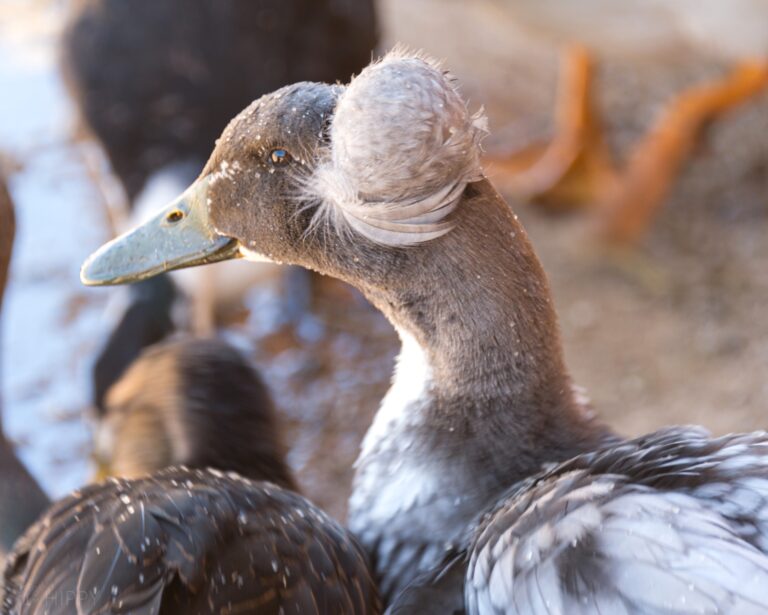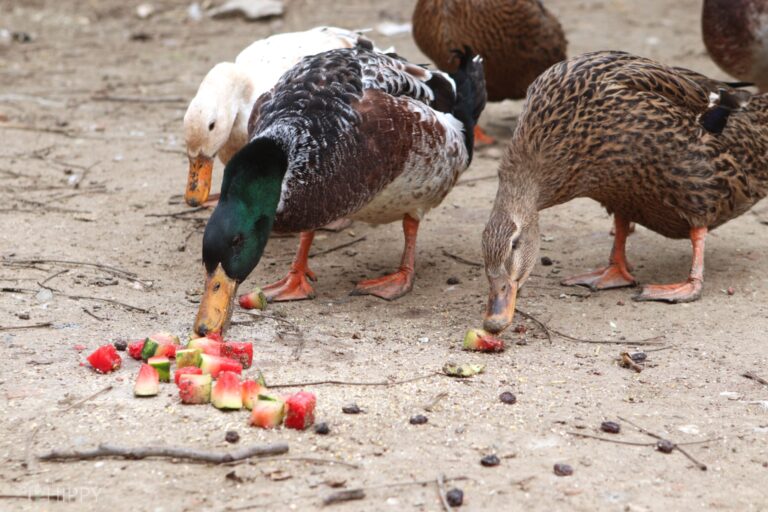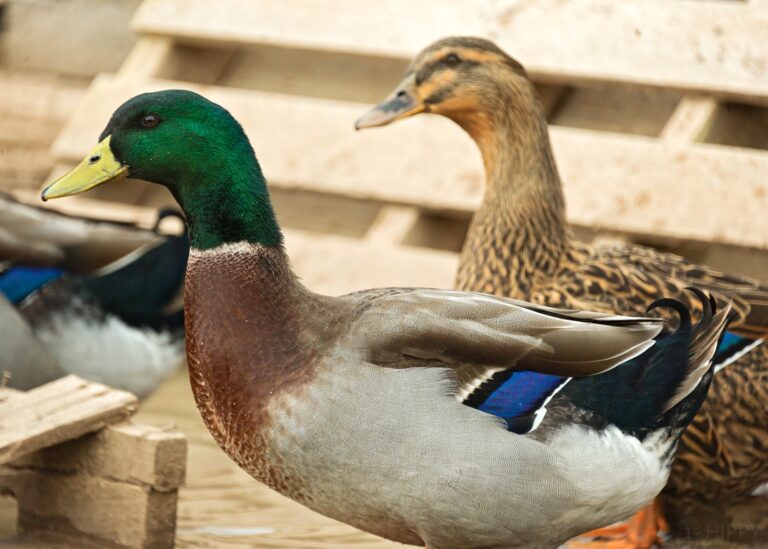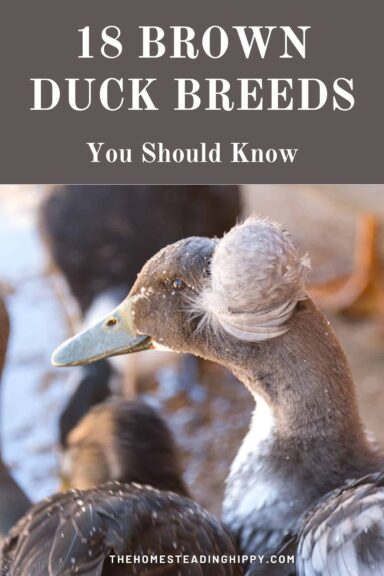One of the greatest joys about owning poultry and bird watching is spotting all the different kinds and colors of birds that are out there.
Truly, they come in every color of the rainbow, but if there’s one color that gets overlooked more often than not, I would say it has to be brown. I know that’s certainly the case when it comes to ducks!
Compared to the scintillating blue-green of the Cayuga or the knockout, gorgeous riot of colors that is the Mandarin, brown ducks seem to get ignored. And I think that’s a shame because some of these brown beauties are among the most elegant, intriguing, and beautiful kinds of waterfowl out there.
It might take a refined eye to better appreciate a brown duck, but you’ll find there’s lots to love about them whether you’re looking for a domestic breed to add to your flock or are just watching for new arrivals down at the lake.
Keep reading and I’ll tell you about 18 brown duck breeds that you need to know…
Most Female Ducks are Some Shade of Brown.
Before we get started, one quick note I’d like to remind readers of: out of the dozens and dozens of duck breeds and species out there in the world, the vast majority of females are brown in some way.
It might range from chocolate brown to mahogany, tan to taupe, or even a sandy coyote color, but no matter the pattern, the ladies tend to be brown with few exceptions.
This just makes sense, of course, because brown animals tend to blend in, and these diligent mamas need all the camouflage they can get for keeping themselves and their nests safe.
But for the purposes of our list, I’m only including breeds where males and females have major brown coloration or are brown for at least a significant part of their lives.
If you’re already a duck fan, you’ll notice a couple of colorful breeds on this list, but even so, they have major patches of brown, or else their post-molt feathers are a more subdued brown compared to the lively ones they get in mating season.
With that understood, let’s get to the list.
Domestic Ducks

Blue Swedish
A larger domestic breed and one that is, sadly, endangered in America but more common and popular in Europe.
Today they’re mostly kept as ornamentals or for hobby flocks due to their liveliness and foraging abilities, but they have some utility as a dual-use breed considering their meat is said to be sweet and rich and they are also modest layers of eggs, averaging about 100 a year.
Blue Swedish ducks are notable for their steely blue and rust-colored feathers, a relatively rare trait that results from a dilution gene that does exactly what it says to their normally black feathers.
The color ranges anywhere from a slate gray to a dark mahogany or rusty brown and combined with the usual iridescence gives them a blue sheen in sunlight, hence the name.
Note also that these ducks tend to look browner and browner as they age, and senior Blue Swedishes might lack that typical blue coloration almost entirely.
Khaki Campbell Ducks
One of the most famous domestic breeds out there and rightly so, the Khaki Campbell is a popular pet duck and also a wonderful choice for an all-around and productive flock.
Although firmly in the medium-size category, they are good producers of tender, high-quality meat and supreme egg layers, with healthy females regularly laying more than 300 eggs every single year. There are some chickens that can’t keep up with them!
And, just like the name says, the Khaki Campbell has an even, medium khaki or coyote brown color all over, often punctuated with darker brown speckles and a near uniformly brown head. This contrasts beautifully with their black bills.
One thing to keep in mind with these hard workers is that they tend to be good flyers and will fly the coop if you don’t clip their wings. If that isn’t an option for you or not something you’re willing to do, consider keeping them in a covered run.
Buff Orpington Duck
The Buff Orpington, sometimes just called the Orpington or even just the Buff Duck, is a larger domestic breed that maxes out at about 8 pounds or a little more in the case of drakes.
Just like the name says, it has an even but slightly modeled all-over fawn color, often accented by white markings above the eyes and white feathers at the tips of the wings and tail.
Famously friendly, surprisingly self-sufficient, and remarkably productive in terms of eggs and meat, these birds are known to gain weight quickly and are ready for slaughter in as little as 8 weeks.
And if it’s eggs you are after, they can give you plenty of those too, laying anywhere from 150 to 200 eggs yearly or even a little more.
A fun fact is that they hail from the same farms in the UK that developed the Orpington chicken, and that’s why they have the name!
Hook Bill
An instantly identifiable domestic breed, and yet another duck that has a highly informative name, Hook Bills have gently curving bills that look almost like a sickle. And this is no defect, as this curvature makes them extremely efficient foragers.
Having a speckled, intermingled brown coloration consisting of lighter and darker patches, they are also attractive!
And, even more surprisingly, they are kept for more than just their interesting looks as they are good layers, with young and healthy hens capable of producing more than 220 eggs every year.
They’re also famous for being easy to handle, docile, and friendly with people as long as you take the time to raise them with plenty of interaction and proper socialization.
You don’t see too many of them here in America, but they are out there, available mostly from specialist breeders and hatcheries.
Welsh Harlequin
A rare, gorgeous, and beloved domestic breed, the Welsh Harlequin is a medium duck that maxes out at about 5 ½ lb, and they are a genuine multipurpose breed, kept for a variety of reasons.
Some folks prefer to keep them as pets or show birds owing to their quiet nature, curious, active demeanor, and close social bonding. They also happen to be remarkably good foragers and are a great breed if you have a larger property that is rich with edible plants, insects, and small invertebrates.
Welsh Harlequins come in a variety of colors, but the brown variation on our list consists of a pale, creamy tan base color accented by dark brown stripes and medium, chocolate brown spots. All these ducks have a dark blue-black bill.
One thing to note is that there are many imposters and hybrids out there owing to the rarity of this breed, so make sure you only try to get them from a vetted and trusted provider, or else you might not have a Welsh Harlequin at all.

Mallard
Even if you don’t know a thing about ducks, chances are you know a little bit about mallards. That’s because they are the single most common duck in the world, even in captivity!
Bright white Pekins are more popular in the United States, but Mallards are still a common sight in backyards and homesteads around the country.
Females, as ever, are a speckled mix of browns while males have a contrasting pattern of tan, brown, black, off-white, and of course, those gorgeous emerald-green heads.
But these colors don’t last in the case of the boys, as they will darken considerably after the summer molt ahead of migration.
It can be tough to tell them apart from the ladies at this point, but here’s a tip: look for the yellow tinge of a drake’s bill. Mallards are tiny, rarely weighing more than 3 ½ pounds, but they make good pets and are able suppliers of small eggs.

Rouen
At first glance, Rouens can easily be mistaken for Mallards, but if you look closely, you’ll notice that these birds are considerably larger than their relatively tiny cousins.
Males have a similar coloration with a pale gray breast, rusty red neck, emerald head, and mottled brown back and flanks, and females look quite similar overall except for their size, being a speckled brown with a scale-like pattern.
But whereas a mallard doesn’t make a very good meal, a Rouen is just the opposite: these ducks are big and bulky, with drakes reaching an astonishing 12 lb or a little bit more.
Their meat is also said to be particularly succulent with excellent marbling, though they’re reasonable layers of eggs, producing up to 125 a year (though some hens are far less productive).
You’ve got to be careful, too, with females, because they’re so big and heavy that they tend to crush eggs if you don’t stay on top of collection duty.
Wild Ducks
Northern Pintail
The Northern Pintail is one of the single most striking wild ducks in North America, and instantly recognizable for its two-tone gray and off-white body, mahogany brown head and wings, and its long, tapering needle-like tail feathers and almost serrated trailing edges on the wings.
These ducks certainly look athletic, and they are also notably extremely fast flyers.
Like most ducks, and wild ducks in particular, females look significantly more subdued than the males with a pale tan head and neck and mixed brown feathers all along their back, flank, and tail.
Sadly, disruption of their usual home and migratory ranges and pressure from human habitation have put this species in distress, and it’s now on federal watch lists in the US and Canada.
Mallard
Surprise! The Mallard is on here twice, but it is for a good reason: there are domestic mallards, and wild mallards, and the two species are now distinct enough that scientists are concerned about the domestic variety intermingling with the wild variety.
But the wild Mallards, visually, are nearly indistinguishable from their domestic cousins, with drakes having bright and ostentatious heads and brown backs that will dampen down to a more uniform brown and tan after molting, while females keep their brown feathers at all times.
American Wigeon
Gorgeous and charismatic duck, and one with a big, almost babyish round head, the tiny American Wigeon has a uniformly medium brown body and breast, or else a slightly speckled, scale-like pattern running down the back that looks sort of like swirl marks.
Males and females also have elegant crescent markings stretching back off of the head and down the neck from each eye.
They are easily detected by their loud, clear whistling call, but it’s tough to get close to them because they are so easy to spook and they tend to fly off at the first disturbance.
Your best chance of spotting them on the water is to catch them while they are asleep; they tuck their entire heads under their wings, and if you’re quiet, you might be able to get close enough for a picture.
Ruddy Duck
The Ruddy duck is more “truth in advertising” for wild species, possessing a dark, rust-colored body from front to back, accented only by darker patches on the breast and tail feathers.
The heads have a two-tone black and white coloration from top to bottom, and most notably a magnificently gorgeous light turquoise bill.
And, again like most wild ducks, Ruddy ducks are quite tiny, rarely weighing even 2 pounds. Despite this, they have a strangely chunky appearance, and they look very heavy and dense for their size.
Northern Shoveler
Certainly one of the strangest dabbling breeds to be seen in the wild, the Northern Shoveler again provides a substantial clue to its behavior right in the name: they have a remarkably wide, thick, and flattened bill, one that they use to scrape along the bottom of the water for things to eat.
And their bill looks out of all proportion with the rest of their bodies; these little ducks weigh just one and a half to barely two pounds on average!
Here we do see some variation in the colors of males and females, though. Females are the expected speckled brown from front to back – although they have an attractive brown-green bill. Males are mostly brown, but show more variation with a toasty brown underside and belly, white breast and rust-red flanks and back along with gorgeous iridescent green heads. You won’t forget this breed if you see them!
Gadwall
The Gadwall is a wild duck that, at first, looks quite plain. But it is only on closer inspection that the beauty and intricacy of their grain-brown plumage will reveal itself.
The feathers have a tight, intricate, grained pattern consisting of alternating, zigzagging bands of a leather brown and pale, dusky gray. The tail feathers and the tips of the wing feathers are alternately black or bright, pure white. Gorgeous!
And compared to many wild species, you won’t see gadwalls in huge flocks, at any time: they tend to keep themselves in small groups or even in bonded pairs.
Blue-Winged Teal
A gorgeous North American breed, and one of the most spectacular species on our list, the Blue-Winged teal can be found all over the North American continent and is instantly recognizable but speckled, golden tan, and dark brown colors.
Males and females have a steel-blue bill, but drakes alone have patches of sky-blue feathers on their wings set off by white-laced black tail feathers and white and black markings on the brow and head.
You can look for these birds where they tend to congregate on open, calm bodies of water, though they can sometimes be found hanging out on streams and rivers with a brisk current.
Ponds, lakes, marshes, and streams, along with coastal waterways, are all good places to spot them.
Green-Winged Teal
The Green-Winged teal is not, as the name suggests, interchangeable with the blue-winged teal save for the coloration of a few feathers.
These birds actually look quite different! Females have the expected scaly, mingled brown but this is accented by two beautiful aquamarine patches, one on each wing.
Drakes, though, are a gorgeous study in contrast with a stone-blue to concrete gray color on the underside and wings accented by a dark mahogany brown on the primary wing feathers and a speckled tan and off-white on the breast. The head is a magnificent, lustrous velveteen brown with vivid blue-green crescents behind the eye.
Lesser Scaup
Known as the Broadbill, the Lesser Scaup is another common North American species on our list. With an average weight of just under 2 lb, these small ducks are noteworthy for the dichotomy in appearance between drakes and hens.
In a way, the females are more ostentatious than the males in this case: the ladies have gorgeous golden-brown bodies with dark, mahogany heads. This two-tone look is set off by their orange eyes and white feathers at the cheeks and base of the bills.
Males are arguably better camouflaged but no less intriguing, with a dark-brown-black chest, neck, and head along with trailing edges of the tail feathers. The body and wings are a pale, stone gray, and iridescent lavender color, a contrast that gives them an appearance almost like frost on glass.
Mottled Duck
Only seen on the Gulf Coast of the US, Mexico, and Central America, the Mottled Duck is known as a non-migratory breed that’s just as at home looking for food on land as it is on the water.
Males and females alike look very similar, easily distinguished only by the brighter, lighter heads on the male and their distinctively ice-yellow bills; the bills of females are a dark, muddy color and their heads are a flat gray.
Both sexes, though, have a scaly, laced coloration consisting of a very dark brown primary color bordered by sandy or dun.
American Black Duck
Common throughout North America, the Dusky Duck, more commonly known as the American Black Duck, is a hefty dabbling breed that’s easily recognized by its very dark brown plumage that appears black in most lighting conditions.
The undersides of the wings, along the leading edge, have bright white markings that give them an interesting, “strobing” appearance while in flight. Males and females are difficult to tell apart, with the only noteworthy features being the brighter yellow bill of the male, whereas the females tend to be a dull, olive green with dark stripes on the upper side.
Of particular note with the American Black is the fact that males are one of the only ducks to share incubation duties with females typically taking over about halfway through her term so she can get some food and rest. The rest of the time, he’ll be guarding the nest, her, and the eggs as usual.

Tim is a farm boy with vast experience on homesteads, and with survival and prepping. He lives a self-reliant lifestyle along with his aging mother in a quiet and very conservative little town in Ohio. He teaches folks about security, prepping and self-sufficiency not just through his witty writing, but also in person.
Find out more about Tim and the rest of the crew here.
